Double-Strand Tubing Installation for Xylophones and Metallophones
By: Margaret Swain - 10/30/2015
|
Note: Double-strand tubing installation is appropriate for Studio 49, Sonor, Golden Bridge, and older MEG instruments. We do not recommend installing double-strand tubing on Suzuki instruments because the bars will not sit correctly on the nails.Always begin your repair projects by wearing eye protection. Inexpensive safety glasses can be purchased at any hardware store.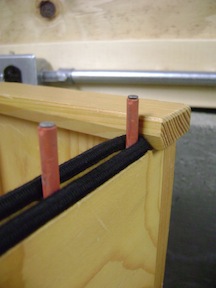
1. Begin with the side of the instrument where the bars sit between the nails rather than over them. Starting at the narrow end of the instrument, loop the tubing over the terminal nail. This will serve to anchor one end of the tubing.
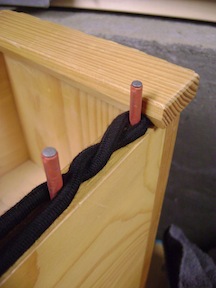
2. For bass instruments, cross the tubing twice, then go around the next nail. For soprano and alto instruments, cross the tubing once between each nail. This photo shows a bass instrument. Do not intentionally stretch the tubing. Apply only enough tension to allow it to lie flat without being loose.

3. Try not to twist the tubing as you cross the strands. For tubing that is already joined at the far end, such as Studio 49 XM-02 and XM-05, cross in one direction between the first set of nails, and cross in the other direction between the next set. Alternating the direction of the crosses between successive nails will reduce the tendency of the tubing to twist along its length.
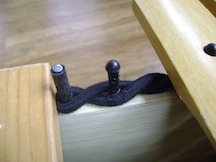
4. For tubing that is not joined at the far end, such as when using a length of ALS1 generic tubing, you may choose to cross in the same direction each time.
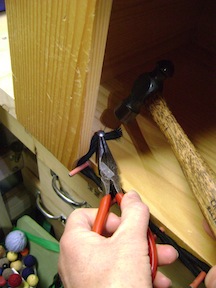
5. When you reach the large end of the instrument, loop one or both strands of the tubing around the final nail, and use a furniture nail* to secure it to the inside of the resonator box. Turn the box on its side, being sure the end plate is allowed to hang over the edge of your table or workbench. Grasp the shaft of the furniture nail with long nose pliers, select a spot that is easy to reach, and not directly beneath the final xylophone nail. Then tap the furniture nail into place.
*The photo shows Hillman furniture nails #122687 available at most hardware stores.
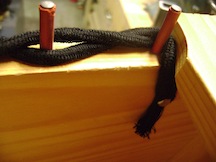
6. Here is a view of the finished installation. As you can see, there is some twist in the tubing since it is difficult to avoid this entirely. The preceding set of photos shows the player’s side of the instrument for Studio 49 and other brands with the bar holes opposite the player.
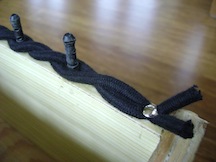
7. Alternatively, for instruments that have enough space at the end, you may choose to tack the tubing as shown above, with either a furniture nail or small wire nail. Set the appropriate bar (either Low C bar or High A) on the instrument first to make sure it will not touch the nail.
The next set of photos shows tubing installation for the opposite side of the instrument.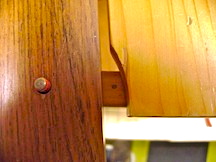 8. On the side of the instrument where the bars fit over the nails, I like to install an extra xylophone nail at each end to guide the tubing in a straight line and prevent it from veering off at an angle. The lowest and highest bars on the instrument will sit more stably with this installation. First determine if there is enough room to install a guide post at each end. If so, mark the position of each post by lightly tapping a depression into the wood with a hammer and nail. 8. On the side of the instrument where the bars fit over the nails, I like to install an extra xylophone nail at each end to guide the tubing in a straight line and prevent it from veering off at an angle. The lowest and highest bars on the instrument will sit more stably with this installation. First determine if there is enough room to install a guide post at each end. If so, mark the position of each post by lightly tapping a depression into the wood with a hammer and nail.
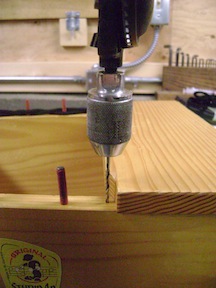
9. Using an extra-long drill bit, drill a pilot hole for your guide post. Warning: never drive a nail into your xylophone without drilling a pilot hole of sufficient length and diameter. Failing to do so will almost certainly split the wood.
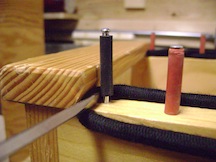
10. Install the tubing starting at the narrow end of the instrument, as in Step 1 above. If the clearance is tight, loop the tubing around the guide post before it is completely installed. Then tap the post in the rest of the way.

11. This view from above shows the guide post anchoring the tubing at the short end of the instrument. Continue the tubing installation as in Steps 2 – 7 above.
© 2015
|
 |
| Back to Category List |
|
 Margaret Swain
Margaret Swain
I enjoy working to connect teachers to quality books and instruments for music and dance education. I hope you find my blog useful and interesting.
|
|
|
|
|
Orff Instrument Repair and Assembly (more)
Courses and Classes for Teachers (more)
Mallets (more)
Product Spotlights (more)
Orff Instruments (more)
|

|
|












 8. On the side of the instrument where the bars fit over the nails, I like to install an extra xylophone nail at each end to guide the tubing in a straight line and prevent it from veering off at an angle. The lowest and highest bars on the instrument will sit more stably with this installation. First determine if there is enough room to install a guide post at each end. If so, mark the position of each post by lightly tapping a depression into the wood with a hammer and nail.
8. On the side of the instrument where the bars fit over the nails, I like to install an extra xylophone nail at each end to guide the tubing in a straight line and prevent it from veering off at an angle. The lowest and highest bars on the instrument will sit more stably with this installation. First determine if there is enough room to install a guide post at each end. If so, mark the position of each post by lightly tapping a depression into the wood with a hammer and nail.



